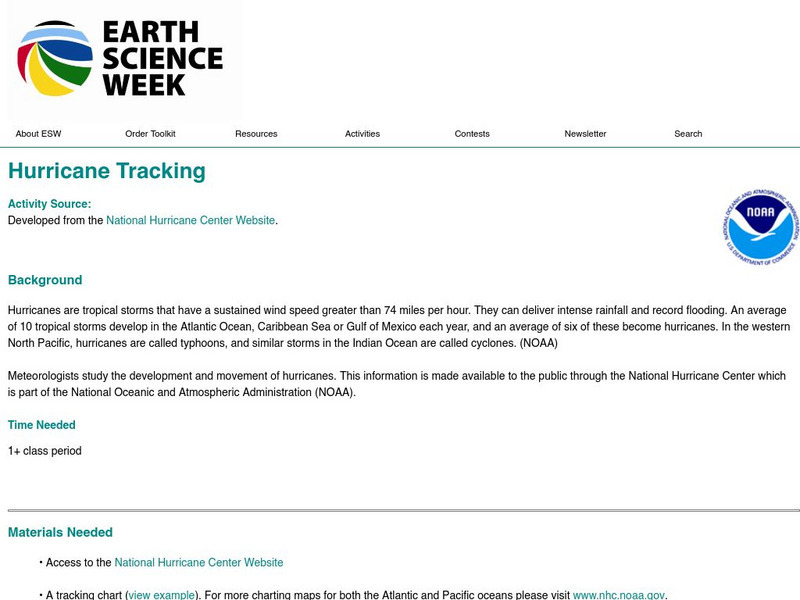NOAA
Noaa: Storm Prediction Center
Get real time data on storms across the nation that have occurred over the past 24 hours. The data includes storm locations, severity and brief damage reports.
American Geosciences Institute
American Geosciences Institute: Earth Science Week: Dangerous Atmosphere
For this activity, students research what types of severe weather their county has had over the past 50-60 years. They will look at the severity of these events and the number of injuries and deaths they caused. They will then decide...
Other
K 3 Learning Pages: Web Resources Thunderstorms
Check out this comprehensive list of web resources on thunderstorms and safety. Students and teachers will benefit from the links found on this site.
Teachers.net
Teachers.net Lesson: Natural Disaster Bloom's Taxonomy
Here is a lengthy activity for student to work on while learning about floods, hurricanes, tornadoes, and earthquakes. Students will enjoy researching these disasters and applying what they have learned to a project.
American Geosciences Institute
American Geosciences Institute: Earth Science Week: Hurricane Tracking
Learners track and plot hurricanes paths for study.
Science Struck
Science Struck: Famous Hurricanes of the World
Describes famous hurricanes that have struck in the Northern Hemisphere since 1900, the regions affected, the intensity of the storms, and the extent of damage each caused. The hurricanes are organized in sequential order.
Other
Kean: Weather Systems [Pdf]
No scientific phenomena concern us as much as the daily evolution of weather systems. We live in a culture where weather, the state of the atmosphere at a given time and place,helps us define regional cultural variations. States such as...
Science Struck
Science Struck: Different Types of Storms
Provides descriptions of a variety of storm types including wintry ones, ones with no precipitation, and very destructive ones. Discusses weather conditions that lead to these storms, precautions one can take, public alerts, etc.
University Corporation for Atmospheric Research
Ucar: Hurricane Safety
If you live in an area that is affected by hurricanes, it is important that you and your family create a plan for what to do in a hurricane, and pull together an emergency supply kit.
University Corporation for Atmospheric Research
Ucar: What a Blizzard Needs
Learn the three ingredients that make a large snowstorm or blizzard.
University Corporation for Atmospheric Research
Ucar: Thunderstorm Safety
Learn the safety guidelines for lighting and thunderstorms.
University Corporation for Atmospheric Research
Ucar: Where Do Hurricanes Form
If you are looking for a hurricane, head to the tropics just north and south of the equator.
University Corporation for Atmospheric Research
Ucar: How Thunderstorms Form
Learn how most thunderstorms form with three stages: the cumulus stage when storm clouds form, the mature stage when the storm is fully formed, and then the dissipating stage when the storm weakens and breaks apart.
University Corporation for Atmospheric Research
Ucar: How Tornadoes Form
Only about one thunderstorm in a thousand produces tornadoes. Learn how tornadoes form.
University Corporation for Atmospheric Research
Ucar: Tornadoes
A dark funnel of cloud extends below a storm. If it reaches the ground, it's a tornado.
University Corporation for Atmospheric Research
Ucar: Hurricanes
A strong hurricane can spell disaster. These huge storms are the most powerful of all weather systems. Learn about how they form and the impacts they can have.
University Corporation for Atmospheric Research
Ucar: Snowstorms
Hoping for a snow day? Consider the meteorological circumstances that would be needed for you to get your wish.
University Corporation for Atmospheric Research
Ucar: Thunderstorms
Right now there are about two thousand thunderstorms going on around the world. While common, they can be dramatic with intense rain, hail, wind, lightning, thunder, and even tornadoes.
CK-12 Foundation
Ck 12: Earth Science: Severe Weather Study Guide
[Free Registration/Login may be required to access all resource tools.] This study guide summarizes the key points of thunderstorms, tornadoes, mid-latitude cyclones, hurricanes, blizzards, and heatwaves and droughts. Includes a few...
Better Lesson
Better Lesson: Design Solutions Engage, Explore
Third graders illustrate and write out notes for a plan (or several plans) to mitigate the effects of a local weather hazard.
University Corporation for Atmospheric Research
Ucar: Kids Crossing: Look Out for Dangerous Weather
Explore dangerous weather events like tornadoes, hurricanes, thunderstorms, and blizzards through stories, activities, and safety tips.
University Corporation for Atmospheric Research
Ucar: Get the Picture Severe Weather
Students review graphs and charts of severe weather data then answer "True and False" questions about the content conveyed.
Alabama Learning Exchange
Alex: Exploring Weather Disasters
During this lesson plan, students will discover the differences in four types of weather disasters. They will collect information from selected Internet websites and create a multimedia presentation to demonstrate what they have learned.
Alabama Learning Exchange
Alex: Researching Hurricanes With Technology
This lesson will help learners to understand the formation, power, and history of hurricanes. Students will do this using a combination of technological skills. Examples of technology used include: PowerPoint, Word, Netscape Composer,...









